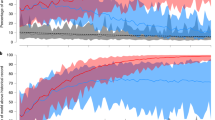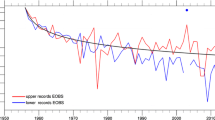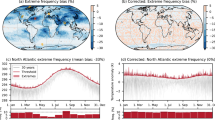Abstract
Consensus on global warming is the result of multiple and varying lines of evidence, and one key ramification is the increase in frequency of extreme climate events including record high temperatures. Here we develop a metric—called “record equivalent draws” (RED)—based on record high (low) temperature observations, and show that changes in RED approximate changes in the likelihood of extreme high (low) temperatures. Since we also show that this metric is independent of the specifics of the underlying temperature distributions, RED estimates can be aggregated across different climates to provide a genuinely global assessment of climate change. Using data on monthly average temperatures across the global landmass we find that the frequency of extreme high temperatures increased 10-fold between the first three decades of the last century (1900–1929) and the most recent decade (1999–2008). A more disaggregated analysis shows that the increase in frequency of extreme high temperatures is greater in the tropics than in higher latitudes, a pattern that is not indicated by changes in mean temperature. Our RED estimates also suggest concurrent increases in the frequency of both extreme high and extreme low temperatures during 2002–2008, a period when we observe a plateauing of global mean temperature. Using daily extreme temperature observations, we find that the frequency of extreme high temperatures is greater in the daily minimum temperature time-series compared to the daily maximum temperature time-series. There is no such observable difference in the frequency of extreme low temperatures between the daily minimum and daily maximum.






Similar content being viewed by others
Notes
The term “draw” in this paper refers to the sampling from a distribution as opposed to the sometimes British English usage of the term to refer to a tie.
We assume that the temperature distribution is continuous. Otherwise we need to deal with ties of temperature observations that happen with positive probability, which unnecessarily complicates the presentation of Rényi (1962) result below.
As mentioned earlier, although we assume that the n draws come from the same initial distribution the transformed distribution by taking the maximum of n such draws clearly represents a change in the underlying distribution.
As defined earlier, the record high (low) temperature at time t is the highest (lowest) temperature observed up to time t.
Although one can also estimate RED-H for the minimum of monthly average temperatures and vice versa, here we are interested in how the “extreme” monthly average temperatures become more extreme over time in order to examine changes in the tails of the temperature distribution.
Although the use of the same time series for both high and low record samples implies that for any month-grid pair we cannot set both a high and low temperature record in any given time period, this restriction does not qualitatively change our results as long as the time-series is sufficiently long.
The grid resolutions we tested include 2° × 2°, 5° × 5°, 8° × 8° and 10° × 10°.
Prior to the 1950s longer time series data on extreme temperatures are available only for a few countries, including the US, Canada and the former USSR. In this limited geographic context (prior to the 1950s) there is neither a strong upward nor downward trend, nor any uniform trends across the different regions (Karl et al. 1984, 1991, 1993; Kumar et al. 1994; Weber et al. 1994; Bonsal et al. 2001).
The comparison of DelCCR2 and HadCRUT3v (on landmass) from 1930 to 1969 is found in the online supplementary material.
For comparison purposes, we reconstruct the record high and record low indicators from the single time-series for each month-grid pair in DelCCR2 as in HadCRUT3v.
Implementing multiple simulations for random tie-breaks in temperature observations is computationally costly when the data set is an unbalanced panel.
All estimates of RED are statistically significant at less than 1% level of significance even in the case of the coarsest data set with 8° × 8° resolution.
The exception is RED-L Mn for 2007 and 2008 where it is higher in the 8° × 8° grid resolution than it is across the other grid resolutions.
In more technical terms, recall that a RED-H Mx estimate of 16 in the tropics means that the transformed distribution is generated by taking the maximum of 16 draws from its base distribution, and a RED-H Mx estimate of 7 in extratropics means that the transformed distribution is only from a maximum of 7 draws (See Eq. 1).
Cochrane-Orcutt AR(1) regression (Cochrane and Orcutt 1949; Breusch and Pagan 1979) is simply the generalized least-squares method to estimate the parameters in a linear regression model in which the errors are assumed to follow a first-order autoregressive process AR(1). For the time series of our RED, the partial autocorrelation for lags larger than one is generally not significant and so we restricted it to an AR(1) process. Our procedure uses an iterative process to find the best autocorrelation coefficient. A similar procedure is used in Wang and Swail (2001), which is applied in Zhang and Zwiers (2004) for climate data.
Note that the R-squared in Cochrane-Orcutt AR(1) cannot be compared with the counterpart in the OLS since it comes from the transformed dependent variable on the transformed independent variables.
This observation is robust when the time window is restricted to 2002–2007.
References
Alexander LV et al (2006) Global observed changes in daily climate extremes of temperature and precipitation. J Geophys Res 111:D05109. doi:10.1029/2005JD006290
Arnold BC, Balakrishnan N, Nagaraja HN (1998) Records. John Wiley, New York
Ballerini R, Resnick SI (1985) Records from improving populations. J Appl Probab 22:487–502
Battisti DS, Naylor RL (2009) Historical warnings of future food insecurity with unprecedented seasonal heat. Science 323:240–244
Benestad RE (2003) How often can we expect a record event? Clim Res 25:3–13
Bonsal BR, Zhang X, Vincent LA, Hogg WD (2001) Characteristics of daily and extreme temperatures over Canada. J Climate 14:1959–1976
Breusch TS, Pagan AR (1979) A simple test for heteroskedasticity and random coefficient variation. Econometrica 47:1287–1294
Brohan P, Kennedy JJ, Harris I, Tett SFB, Jones PD (2006) Uncertainty estimates in regional and global observed temperature changes: a new dataset from 1850. J Geophys Res 111:D12106. doi:10.1029/2005JD006548
Caesar J, Alexander L, Vose R (2006) Large-scale changes in observed daily maximum and minimum temperatures: Creation and analysis of a new gridded data set. J Geophys Res 111:D05101. doi:10.1029/2005JD006280
Chandler KN (1952) The distribution and frequency of record values. J Royal Stat Soc B 14:220–228
Choi G et al (2009) Changes in means and extreme events of temperature and precipitation in the Asia-Pacific network region: 1955–2007. Int J Climatol 29:1906–1925
Ciais Ph et al (2005) Europe-wide reduction in primary productivity caused by the heat and drought in 2003. Nature 437:529–533
Cochrane D, Orcutt GH (1949) Application of least squares regression to relationships containing auto-correlated error terms. J Am Stat Assoc 44:32–61
Curriero FC, Heiner K, Zeger S, Samet JM, Patz JA (2002) Temperature and mortality in 11 cities of the eastern United States. Am J Epidemiol 155:80–87
Easterling DR et al (1997) Maximum and minimum temperature trends for the globe. Science 277:364–367
Easterling DR et al (2000) Climate extremes: observations, modeling, and impacts. Science 289:2068–2074
Frich P et al (2002) Observed coherent changes in climatic extremes during the second half of the twentieth century. Clim Res 19:193–212
Githeko AK, Ndegwa W (2001) Predicting malaria epidemics in the Kenyan Highlands using climate data: a tool for decision makers. Glob Change Hum Health 2:54–63
Gordon AH (1992) Interhemispheric contrasts of mean global temperature anomalies. Int J Climatol 12:1–9
Griffiths GM et al. (2005) Change in mean temperature as a predictor of extreme temperature change in the Asia–Pacific region. Int J Climatol 25:1301–1330
Gumbel EJ (1958) Statistics of extremes. Columbia University Press, New York
Hall P, Tajvidi N (2000) Nonparametric analysis of temporal trend when fitting parametric models to extreme-value data. Stat Sci 15:153–167
Hay SI et al (2002) Climate change and the resurgence of malaria in the East African highlands. Nature 415:905–909
Hunter DE, Schwartz SE, Wagener R, Benkovitz CM (1993) Seasonal, latitudinal, and secular variations in temperature trend: evidence for influence of anthropogenic sulfate. Geophys Res Lett 20:2455–2458
Jones PD, Briffa KR (1992) Global surface air temperature variations during the twentieth century: part 1, spatial, temporal and seasonal details. Holocene 2:165–179
Jones PD et al (1999) Surface air temperature and its changes over the past 150 years. Rev Geophys 37:173–199
Karl TR, Kukla G, Gavin J (1984) Decreasing diurnal temperature range in the United States and Canada from 1941 through 1980. J Clim Appl Meteorol 23:1489–1504
Karl TR et al (1991) Global warming: evidence for asymmetric diurnal temperature change. Geophys Res Lett 18:2253–2256
Karl TR et al (1993) Asymmetric trends of daily maximum and minimum temperature. B Am Meteorol Soc 74:1007–1023
Kharin VV, Zwiers FW (2000) Changes in the extremes in an ensemble of transient climate simulations with a coupled atmosphere-ocean GCM. J Climate 13:3760–3788
Kiktev D, Sexton D, Alexander L, Folland C (2003) Comparison of modelled and observed trends in indicators of daily climate extremes. J Climate 16:3560–3571
Kumar RK, Kumar KK, Pant GB (1994) Diurnal asymmetry of surface temperature trends over India. Geophys Res Lett 21:677–680
Laurent C, Parey S (2007) Estimation of 100-year-return-period temperatures in France in a non-stationary climate: Results from observations and IPCC scenarios. Glob Planet Change 57:177–188
Lean JL, Rind DH (2008) How natural and anthropogenic influences alter global and regional surface temperatures: 1889 to 2006. Geophys Res Lett 35: L18701. doi:10.1029/2008GL034864
Lean JL, Rind DH (2009) How will Earth’s surface temperature change in future decades? Geophys Res Lett 36:L15708. doi:10.1029/2009GL038932
Lund R, Reeves J (2002) Detection of undocumented changepoints: a revision of the two-phase regression model. J Climate 15:2547–2554
Lund R, Seymour, L, Kafadar K (2001) Temperature trends in the United States. Environmetrics 12:673–690
Meehl GA, Tebaldi C, Walton G, Easterling D, McDaniel L (2009) Relative increase of record high maximum temperatures compared to record low minimum temperatures in the U.S. Geophys Res Lett 36:L23701. doi:10.1029/2009GL040736
Munasinghe L, O’Flaherty B, Danninger S (2001) Globalization and the rate of technological progress: what track and field records show. J Polit Econ 109:1132–1149
Nevzorov VB (1985) Record and interrecord times for sequences of nonidentically distributed random variables. J Math Sci 36:510–516. doi:10.1007/BF01663462
Nogaj M, Yiou P, Parey S, Malek F, Naveau P (2006) Amplitude and frequency of temperature extremes over the North Atlantic region. Geophys Res Lett 33:L10801. doi:10.1029/2005GL024251
Parmesan C, Yohe G (2003) A globally coherent fingerprint of climate change impacts across natural systems. Nature 421:37–42
Peterson TC (2005) Climate change indices. WMO Bulletin 54:83–86
Rényi A (1962) Theorie des elements saillants d’une suite d’observations. Colloquium on Combinatorial Methods in Probability Theory, pp 104–117
Rittenhouse CD et al (2010) Avifauna response to hurricanes: regional changes in community similarity. Glob Change Biol 16:905–917
Rosenzweig C et al (2008) Attributing physical and biological impacts to anthropogenic climate change. Nature 453:353–357
Schäl C et al (2004) The role of increasing temperature variability in European summer heatwaves. Nature 427:332–336
Thibault KM, Brown JH (2008) Impact of an extreme climatic event on community assembly. Proc Natl Acad Sci USA 105:3410–3415
Trenberth KE et al (2007) Observations: surface and atmospheric climate change. In: Solomon et al (eds) Climate change 2007: the physical science. Cambridge University Press, New York
Walther GR et al (2002) Ecological responses to recent climate change. Nature 416:389–395
Wang XL, Swail VR (2001) Changes of extreme wave heights in northern hemisphere oceans and related atmospheric circulation regimes. J Climate 14:2204–2221
Weber RO, Talkner P, Stefanicki G (1994) Asymmetric diurnal temperature change in the Alpine Region. Geophys Res Lett 21:673–676
Willmott CJ, Matsuura K (1995) Smart interpolation of annually averaged air temperature in the United States. J Appl Meteorol 34:2577–2586
Yan Z (2002) Trends of extreme temperatures in Europe and China based on daily observations. Clim Change 53:355–392
Yang MCK (1975) On the distribution of the inter-record times in an increasing population. J Appl Probab 12:148–154
Yiou P, Goubanova K, Li ZX, Nogaj M (2008) Weather regime dependence of extreme value statistics for summer temperature and precipitation. Nonlinear Process Geophys 15:365–378
Zhang X, Vincent LA, Hogg WD, Niitsoo A (2000) Temperature and precipitation trends in canada during the 20th century. Atmos Ocean 38:395–429
Zhang X, Zwiers FW (2004) Comment on “Applicability of prewhitening to eliminate the influence of serial correlation on the Mann-Kendall test” by Yue S, Wang CY. Water Resour Res 40. doi:10.1029/2003WR002073
Zwiers FW, Kharin VV (1998) Changes in the extremes of the climate simulated by CCC GCM2 under CO2 doubling. J Climate 11:2200–2222
Zwiers FW, Zhang X, Feng J (2011) Anthropogenic influence on long return period daily temperature extremes at regional scales. J Climate 24:881–892
Acknowledgements
DelCCR2, HadCRUT3v, and ETCCDI data were provided by the Center for Climatic Research at the University of Delaware, Climate Research Unit at the University of East Anglia, and Expert Team on Climate Change Detection and Indices, respectively. We gratefully acknowledge financial support from the Kyung Hee University Research Grant (2009) and Barnard College Presidential Research Award (2010). The primary research was conducted while the second author was a Research Fellow at Barnard College, and on sabbatical leave from Kyung Hee University. He would like to thank both institutions for providing invaluable support to conduct research on climate change. We thank three anonymous referees for their constructive criticisms and many helpful suggestions.We also thank Cynthia Howells, Brendan O’Flaherty, Stephanie Pfirman, Sanjay Tikku, Moonkyoung Um, and Jerry Welch for encouragement and generous feedback on earlier versions of the paper. Finally, we thank Claire Fram and Britt Johnson for excellent research assistance.
Author information
Authors and Affiliations
Corresponding author
Electronic Supplementary Material
Rights and permissions
About this article
Cite this article
Munasinghe, L., Jun, T. & Rind, D.H. Climate change: a new metric to measure changes in the frequency of extreme temperatures using record data. Climatic Change 113, 1001–1024 (2012). https://doi.org/10.1007/s10584-011-0370-8
Received:
Accepted:
Published:
Issue Date:
DOI: https://doi.org/10.1007/s10584-011-0370-8




